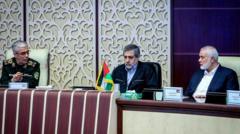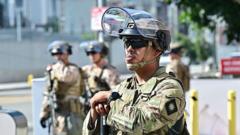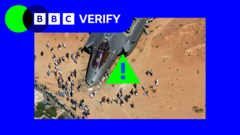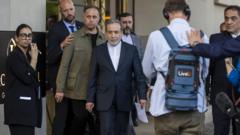The recent U.S. military strikes on Iran mark a significant escalation in the ongoing conflict, provoking fears of a wider war in the Middle East and prompting Iranian threats of retaliation.
**U.S. Military Action Against Iran Escalates Tensions in the Middle East**

**U.S. Military Action Against Iran Escalates Tensions in the Middle East**
President Trump announces targeted strikes on Iran’s key nuclear facilities as the conflict between Israel and Iran intensifies.
In a dramatic escalation of tensions in the Middle East, President Donald Trump announced on Saturday the United States’ military action against Iran, directly involving American forces in Israel's conflict with the Islamic Republic. U.S. bombers targeted three strategic nuclear sites, including the heavily fortified Fordo facility, which is crucial to Iran's nuclear enrichment program.
In a late-night communication, President Trump declared that American warplanes executed strikes on the Fordo facility and other locations, saying, “All planes are now outside of Iran airspace.” Reports indicate that the strikes were conducted around 2:30 a.m. local time, targeting Iran’s significant nuclear sites, including the Natanz plant and a third site near Isfahan, purported to house near-bomb-grade enriched uranium.
The military action follows a series of escalating attacks between Israel and Iran that began on June 13, ignited by Israeli airstrikes on Iranian infrastructure. Prime Minister Benjamin Netanyahu described the operations as necessary to prevent a nuclear catastrophe, while Iranian officials warned that the U.S. intervention would not go unchallenged.
In a startling departure from his previous stance of avoiding extended military engagements abroad, Trump authorized the use of powerful bunker buster bombs, uniquely capable of piercing the depths of Iran's fortified sites like Fordo. Following days of deliberation, during which the president threatened Iranian leadership, he reached a decision to support Israel’s efforts against Iranian nuclear ambitions.
Despite the significant military actions, analysts express concerns about possible retaliatory strikes from Iran, which could jeopardize U.S. military assets and deepen the ongoing conflict. Iran's foreign minister has vowed retaliation, stating that the U.S. should brace for ominous consequences should it enter the conflict militarily.
As the conflict unfolds, American military presence in the region is being bolstered. Reports suggest that additional aircraft, including F-22s, F-16s, and F-35s, are being deployed to secure U.S. bases against potential Iranian reprisals. This military mobilization comes with heightened tensions and unprecedented regional instability amid fears of a broader confrontation.
The international community is watching closely as the situation evolves, with many regional powers apprehending the potential for expanded conflict that could further embroil the Middle East in crisis.
In a late-night communication, President Trump declared that American warplanes executed strikes on the Fordo facility and other locations, saying, “All planes are now outside of Iran airspace.” Reports indicate that the strikes were conducted around 2:30 a.m. local time, targeting Iran’s significant nuclear sites, including the Natanz plant and a third site near Isfahan, purported to house near-bomb-grade enriched uranium.
The military action follows a series of escalating attacks between Israel and Iran that began on June 13, ignited by Israeli airstrikes on Iranian infrastructure. Prime Minister Benjamin Netanyahu described the operations as necessary to prevent a nuclear catastrophe, while Iranian officials warned that the U.S. intervention would not go unchallenged.
In a startling departure from his previous stance of avoiding extended military engagements abroad, Trump authorized the use of powerful bunker buster bombs, uniquely capable of piercing the depths of Iran's fortified sites like Fordo. Following days of deliberation, during which the president threatened Iranian leadership, he reached a decision to support Israel’s efforts against Iranian nuclear ambitions.
Despite the significant military actions, analysts express concerns about possible retaliatory strikes from Iran, which could jeopardize U.S. military assets and deepen the ongoing conflict. Iran's foreign minister has vowed retaliation, stating that the U.S. should brace for ominous consequences should it enter the conflict militarily.
As the conflict unfolds, American military presence in the region is being bolstered. Reports suggest that additional aircraft, including F-22s, F-16s, and F-35s, are being deployed to secure U.S. bases against potential Iranian reprisals. This military mobilization comes with heightened tensions and unprecedented regional instability amid fears of a broader confrontation.
The international community is watching closely as the situation evolves, with many regional powers apprehending the potential for expanded conflict that could further embroil the Middle East in crisis.























